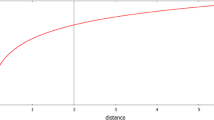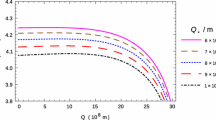Summary
Classical and quantum restrictions are derived for a test particle falling in the gravitational field of a Schwarzschild black hole. It is noted that in general relativity the gravitational mass of the particle increases (in contrast with Newtonian theory) and hence the condition that the test body exerts negligible influence on the central body becomes invalid for sufficiently small distances from the Schwarzschild radius. The effects of complementarity, and the uncertainty principle are also discussed. This analysis also leads to an extremely small quantum distance below which the Schwarzschild geodesic motion is expected to break down. Both the classical and quantum restrictions are smaller than the Planck length for an in-falling electron.
Riassunto
Si derivano le restrizioni classiche e quantistiche per una particella di prova che cade nel campo gravitazionale di un buco nero di Schwarzschild. Si nota che nella relatività generale la massa gravitazionale della particella aumenta (in contrasto con la, teoria newtoniana) e quindi la condizione che il, corpo di prova eserciti un'influenza trascurabile sul corpo centrale perde valore per distanze, sufficientemente piccole dal raggio di Schwarzschild. Si discutono anche gli effetti di complementarità e del principio d'indeterminzione. Questa analisi porta anche ad una distanza quantica estremamente piccola sotto la quale ci si aspetta che il moto geodesico di Schwarzschild venga meno. Sia le restrizioni classiche che quelle quantiche sono più piccole della lunghezza di Planck per un elettrone in caduta.
Резюме
Выводятся классическое и квантовое ограничения для пробной частицы, движущейся в гравитационном поле черной дыры Шварцшильда. Отмечается, что в общей теории относительности гравигационная масса частицы увеличивается (в противоположность нрютоновской теории) и, следовательно, условие, что пробная частица оказывает пренебрежимо малое влияние на центральное тело становится недействительным для достаточно малых расстояний от радиуса Шварцшильда. Также обсужднются эффекты дополнительности и принцип неопределенности. Этот анализ приводит к чрезвычайно малому квантовому расстоянию, инже которого можно ожидатя, что геодезическое движение Шварцшильда нарушается. Классическое и квантовое ограничения оказываются меньше, чем длина Планка для электрона. В Приложении А проверяются и интерпретируются классичесие результаты в координатах Крускала. В Приложении В с помощью внутреннего решения Шварцшильда разрешается проблема ускорения статического наблюдателя. В Приложении С проводится обсиждение предыдущей работы на ту же тему.
Similar content being viewed by others
Literatur
S. W. Hawking:Nature (London),30, 248 (1974);Commun. Math. Phys.,43, 199 (1975).
L. Smarr, A. Cadez, B. DeWitt andK. Eppley:Phys. Rev. D,14, 2443 (1976);L. Smarr: inEighth Texas Symposium on Relativistic Astrophysics, Vol.302 (New York, N. Y., 1977), p. 569;R. E. Kates:Phys. Rev. D,22, 1853 (1980)J. L. Anderson andL. S. Kegeles:Gen. Rel. Grav.,12, 633 (1980).
R. Penrose:Riv. Nuovo Cimento,1, 252 (1969);Sci. Am.,226, 38 (1972);Nature (London),236, 377 (1972).
R. Ruffini andJ. A. Wheeler: inThe Significance of Space Research for Fundamental Physics, ESRO Report SP-52 (Paris, 1971);Phys. Today,24, 30 (1971).
C. DeWitt andB. S. DeWitt, Editors:Black Holes (New York, N. Y., 1972).
C. W. Misner, K. W. Thorne andJ. A. Wheeler:Gravitation, Chap. 33 (San Francisco, Cal., 1973).
M. Rees, R. Ruffini, andJ. A. Wheeler:Black Holes, Gravitational Waves and Cosmology (New York, N. Y., 1974).
S. Chandrasekhar:Contemp. Phys.,14, 1 (1974).
M. Kruskal:Phys. Rev.,119, 1743 (1960);C. Fronsdal:Phys. Rev.,116, 778 (1959);G. Szekeres:Publ. Mat. Debrecen,7, 285 (1960).
R. V. Pound andG. A. Rebka:Phys. Rev. Lett.,4, 337 (1960).
L. Landau andE. M. Lifschitz:Classical Theory of Fields, 3rd edition (Reading, Mass., 1971); 4th edition (London, 1975).
I. B. Zel'dovich andI. D. Novikov:Relativistic Astrophys, Vol.1 (Chicago, Ill., 1971), p. 93.
J. Joffe andI. Shapiro:Phys. Rev. D,6, 405 (1972).
F. Markley:Am. J. Phys.,41, 45 (1973).
G. Cavalleri andG. Spinelli:Phys. Rev. D,15, 3065 (1977);Lett. Nuovo Cimento,22, 113 (1978).
A. I. Janis:Phys. Rev. D,15 3068 (1977).
V. Weisskopf:Phys. Rev.,56, 72 (1939).
J. R. Oppenheimer andH. Snyder:Phys. Rev.,56, 455 (1939).
R. Penrose:Phys. Rev. Lett.,14, 57 (1965).
S. W. Hawking andG. F. R. Ellis:The Large Scale Structure of Space-Time (Cambridge, 1973).
F. R. Tangherlini:Nuovo Cimento,38, 153 (1965); see alsoW. Hillebrandt:Ninth Texas Symposium on Relativistic Astrophysics, edited byJ. Ehlers, J. J. Perry andM. Walker:Ann. N. Y. Acad. Sci.,336, 339 (1980).
B. K. Harrison, K. S. Thorne, M. Wakano andJ. A. Wheeler:Gravitation Theory and Gravitation Collapse (Chicago, Ill., 1965).
C. Møller:The Theory of, Relativity (Oxford, 1952), p. 49, 225; see also 2nd edition.
F. R. Tangherlini:Bull. Am. Phys. Soc.,25, 58 (1980), HI5.
L. Mysak andG. Szekeres:Can. J. Phys.,44, 617 (1966).
N. Rosen:Rev. Mod. Phys.,21, 503 (1949).
P. Havas:Synthese,18, 75 (1968).
F. Zerilli:Phys. Rev. D,2, 2141 (1970).
R. Gautreau:Nuovo Cimento B,49, (1980);Alternatives to Black Holes (preprint). Contains references to earlier work (1978–79).
N. J. Charlton:J. Phys. A.,11, 2207 (1978).
A. Rosenblum:IX International Conference on General Relativity and Gravitation, Abstracts (Jena, 1980), p. 198.
J. A. Wheeler:Beyond the black hole, inSome Strangeness in the Proportion, edited byH. Woolf (Reading, Mass., 1980), p. 341.
F. Dyson:Beyond the black hole, inSome Strangeness in the Proportion, edited byH. Woolf (Reading, Mass., 1980), p. 376.
Author information
Authors and Affiliations
Additional information
This article is dedicated to the commemoration of the one-hundredth anniversary of the birth of Albert Einstein.
Traduzione a cura della Redazione.
Переведено редакуией.
Rights and permissions
About this article
Cite this article
Tangherlini, F.R. Classical and quantum restrictions on geodesic motion near a Schwarzschild black hole. Nuov Cim B 63, 588–600 (1981). https://doi.org/10.1007/BF02755100
Received:
Published:
Issue Date:
DOI: https://doi.org/10.1007/BF02755100




